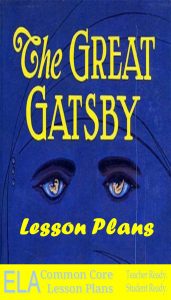There was music from my neighbor’s house through the summer nights. In his blue gardens men and girls came and went like moths among the whisperings and the champagne and the stars. At high tide in the afternoon I watched his guests diving from the tower of his raft, or taking the sun on the hot sand of his beach while his two motor-boats slit the waters of the Sound, drawing aquaplanes over cataracts of foam. Then the summer ended and my neighbor had to go back to teaching The Great Gatsby and other great literature.
I gave him these lesson plans to console him about the end of summer.
Teaching The Great Gatsby
If you’re wondering how to teach The Great Gatsby, I recommend starting with these two lesson plans:
They form the foundation of The Great Gatsby Teaching Unit.
Here’s a day-by-day run down of how to teach The Great Gatsby. It’s a guideline. The class, my mood, the weather, the results of football games, and other things affect what takes place on an individual day. In other words, you’re a professional. You know how to teach. Pace accordingly.
Every day on the list contains a lesson plan and assignment in The Great Gatsby Teaching Unit.

Teaching The Great Gatsby begins with great lesson plans.
Day 1: Modernism notes and discussion. Begin chapter 1.
Day 2: Hand out and explain dialectical journals (that’s the literary analysis lesson plan above). Finish chapter 1. Foreshadowing in chapter 1 chart and assignment.
Day 3: Hand out summary charts and discuss (that’s the chapter summaries assignment pdf above). Complete chapter 1 summary chart. Read chapter 2.
Day 4: Character and setting review. Work on summary and DJ.
Day 5: Goal Setting Assignment, Day 1. Read Chapter 3.
Day 6: Goal Setting Assignment, Day 2: Summary and DJ Charts.
Day 7: Quiz chapters 1-3.
Day 8: Read chapter 4. Point of View Lesson Plan.
Day 9: Finish P.O.V. lesson plan. Work on summary and DJ charts.
Day 10: Read chapter 5. Fill in character charts.
Day 11: Character Pie Chart Assignment.
Day 12: Read chapter 6. Theme Analysis.
Day 13: Quiz chapters 4-6.
Day 14: Read chapter 7. Work on summary and DJ charts.
Day 15: Chapter 7 Point of View Analysis, Part 1.
Day 16: Chapter 7 Point of View Analysis, Part 2.
Day 17: Read chapters 8-9.
Day 18: Theme Bubbles.
Day 19: Modernism Lesson Plan.
Day 20: Review Lesson Plan.
Day 21: Quiz Chapters 7-9
It’s just an outline. You can create your own assignments. Or you could just check out The Great Gatsby Teaching Unit, make copies, and work your magic.
ELA Goals and Objectives
When you ask an administrator how to teach The Great Gatsby, they’ll exercise their authority by blabbering about standards, objectives, and a few acronyms that make themselves sound impressive. So don’t ask. Just focus on these standards when teaching The Great Gatsby.
You could literally cover every single ELA Standard with The Great Gatsby depending on how you teach it. Here are the major Literature Reading standards you’ll cover almost automatically.
- 9-10.1 Cite strong and thorough textual evidence to support analysis of what the text says explicitly as well as inferences drawn from the text.
- 9-10.2 Determine a theme or central idea of a text and analyze in detail its development over the course of the text, including how it emerges and is shaped and refined by specific details; provide an objective summary of the text.
- 9-10.3 Analyze how complex characters (e.g., those with multiple or conflicting motivations) develop over the course of a text, interact with other characters, and advance the plot or develop the theme.
- 9-10.4 Determine the meaning of words and phrases as they are used in the text, including figurative and connotative meanings; analyze the cumulative impact of specific word choices on meaning and tone (e.g., how the language evokes a sense of time and place; how it sets a formal or informal tone).
- 9-10.5 Analyze how an author’s choices concerning how to structure a text, order events within it (e.g., parallel plots), and manipulate time (e.g., pacing, flashbacks) create such effects as mystery, tension, or surprise.
Share This:
